Brentford Hospital
Boston Manor Road, Brentford, Middlesex TW8 8DS
Medical dates:
Medical character:
1892 - 1993
Acute. Later, geriatric.
In 1892 Edward John Stracey Clitherow, owner of Boston Manor, leased
Marlborough House, at 24-26 The Butts, Brentford, for use as a
hospital. The Brentford Dispensary, which had opened in 1818,
moved into Marlborough House, and the building was renamed the
Brentford Dispensary, Cottage Hospital and Nurses' Home.
The two double-fronted houses, which had been built around 1690, were equipped with 6 in-patient beds and also contained accommodation for the nurses, who paid home visits to the sick.
The freehold to Marlborough House was bought in 1902, but the building of the Great West Road during the 1920s had brought more people to the area. The old building had become inadequate and unsuitable and a larger hospital was needed (in 1927, on a daily average, 5 of the 6 beds were occupied, with patients remaining on average for 18 days).
A piece of land of just over an acre, part of 'Gale's Orchard' on the Boston Manor Road, was purchased and, on 11th June 1927, Mrs Thomas Stallabras, the wife of a local worthy, laid the foundation stone for the new hospital.
The Brentford Hospital was officially opened on 19th May 1928 by the President of the Hospital, Col. J.B. Stracey-Clitherow, C.B.E.
The ground floor of the two-storey building had two wards of six beds each with sanitary blocks and bathrooms, as well as two wards of two cots each, a single bed ward, the Nurses' Duty Room, a linen room, Matron's office, the doctors' lavatory, the operating theatre with the anaesthetic and sterilising rooms, the Nurses' sitting room, the kitchen, a scullery and two larders, and a lift and a stairway. The X-ray room was near the Out-Patients Department, which contained a waiting room, an accident and treatment room, a surgery and dispensary, and a lavatory.
The basement contained the boilers and the coke store.
On the first floor were 4 single rooms for private patients, a WC and bathroom, a Nurses' Duty Room, Matron's sitting room, a patients' clothing store, cupboards, and 9 bedrooms for nursing and domestic staff with 2 bathrooms and WCs.
Each bed had a wireless (radio) installation.
The land and the building had cost £17,000. Since the money from the building fund had run out, Mr Thomas Stallabrass, JP, paid for the X-ray equipment and all the hospital furnishings, the Ladies' Linen League supplied all the blankets and linen, and the lift was paid for by the proceeds of a concert at the Chiswick Empire. The concert had been organised by Mr Milne, the last patient in the old Hospital.
During WW2 the Hospital joined the Emergency Medical Scheme with 33 beds.
It joined the NHS in 1948 under the control of the South West Middlesex Hospital Management Committee, part of the North West Metropoltan Regional Hospital Board.
In 1954 the Hospital had 33 beds.
Following a major reorganisation of the NHS in 1974, its management passed to the Hounslow District Health Authority, part of the North West Thames Regional Health Authority.
It ceased to be an acute hospital in 1977 and, in 1979, became instead a geriatric unit with 22 beds for long stay patients who needed some expert nursing care but not daily medical care. A consultant geriatrician from the West Middlesex Hospital attended weekly.
In 1982, following another major reorganisation of the NHS, the Hospital came under the control of the Hounslow and Spelthorne District Health Authority.
It closed at the end of 1993, with the NHS patients being transferred to a private nursing home in Hounslow.
|
Present status (April 2008) The Regional Health Authority hoped to sell the site, but locals reported that it had been purchased with charitable funds. A watertight restrictive covenant was then unearthed. The Hospital building was demolished and its site now contains the Brentford Health Centre, which opened in 1996, and the Brentford Lodge Day Hospital, a mental assessment and respite care centre. |
|---|
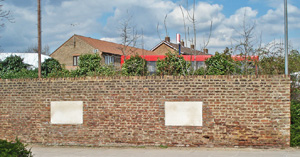
The only remnants of the former Hospital - the foundation stone and the stone laid at the opening ceremony set in the wall by the Health Centre.
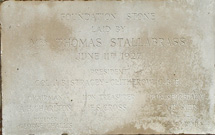
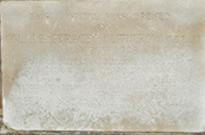
The foundation stone laid by Mrs Thomas Stallabrass in June 1927 (left) and the one laid at the opening ceremony (right) by Col John Bourchier Stracey-Clitherow, CBE, JP, in May 1928.
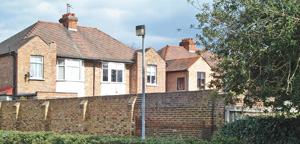
An old wall south of the car park may be part of the original Hospital.
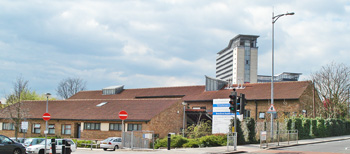
The Brentford Health Centre.
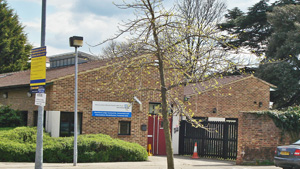
The Brentford Lodge Day Hospital.
| During the 1930s patients were admitted for such medical conditions as bronchopneumonia, pleurisy, diabetes, duodenal ulcer, shingles, influenza, nephritis, uraemia, phlebitis and carcinoma. They were treated surgically for carbuncle, lipoma, hernia and empyema. Laparotomies and appendectomies were also performed. |
References (Accessed 1st August 2015)
Personal communication: Dr Anne Murphy